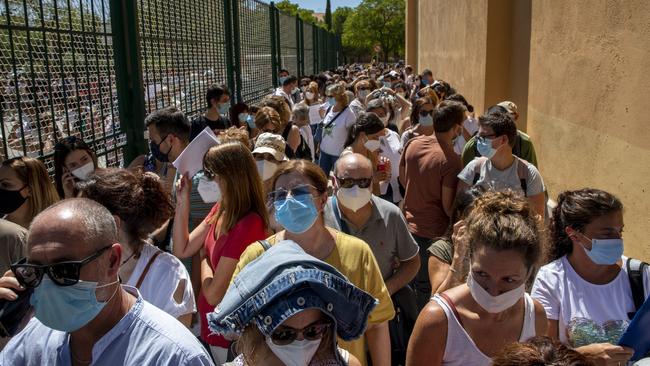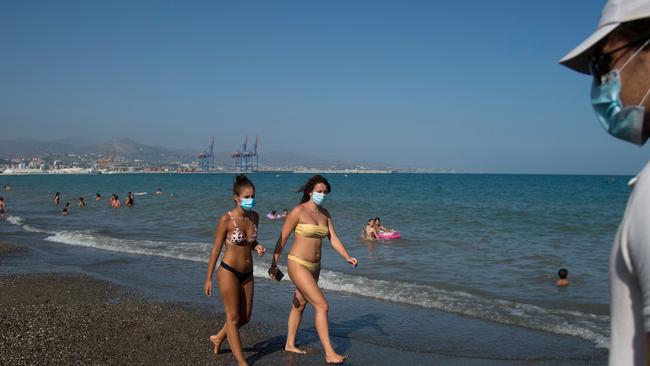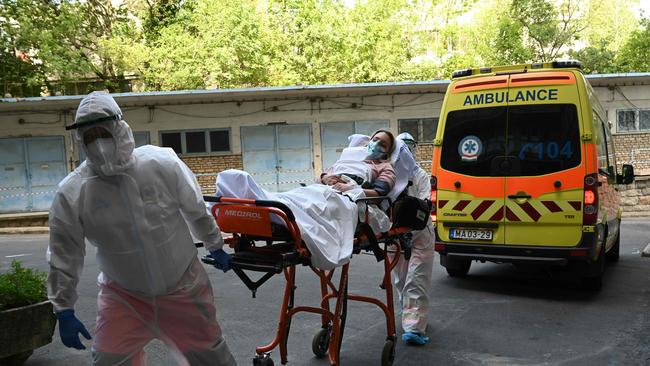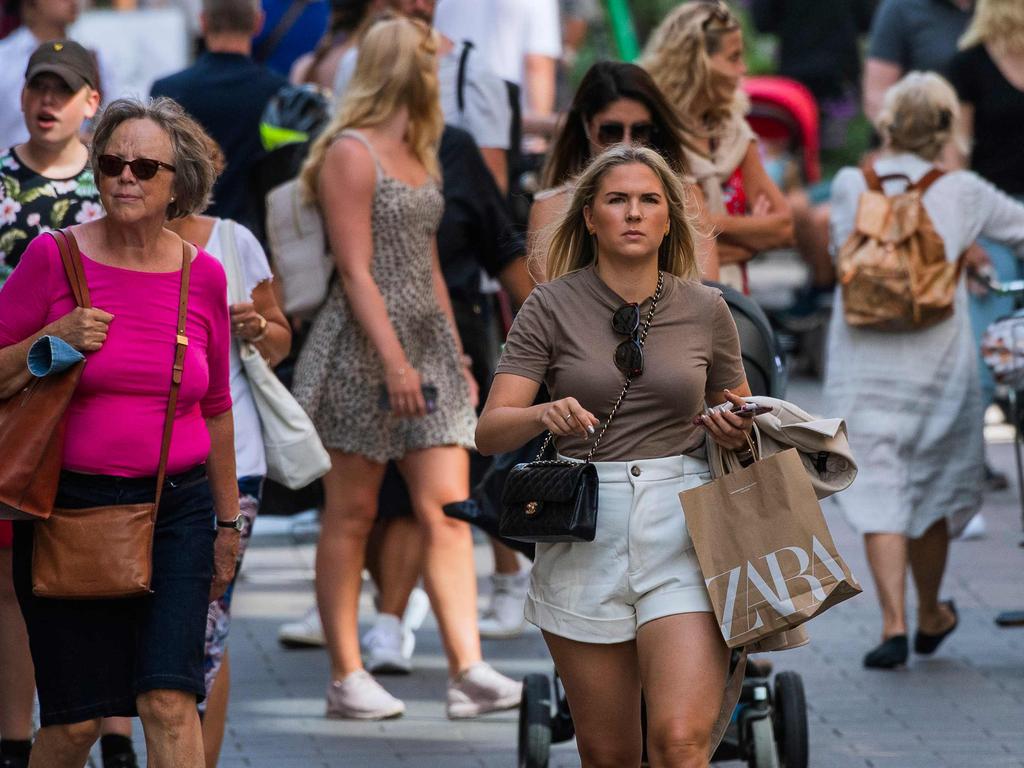Experts question whether COVID is still the killer it was, as cases surge but death rates plunge
As global numbers rise, death rates are plunging. Are we close to a magic formula of precautions and treatments that could soon turn the virus into a manageable nuisance?

Pati Saez was on maternity leave awaiting her third child when the first wave of the coronavirus hit Spain earlier this year. Madrid’s hospitals were swiftly submerged in human suffering. Retirement homes were turned into mortuaries.
The hospital where Saez worked as a gastrointestinal surgeon was “overwhelmed”, she said last week. “Everyone on the medical staff was diverted to dealing with Covid.”
Her baby, Pablo, was delivered safely. Now Saez, 33, is back at work – and worrying about what lies ahead as her hospital braces itself for a new surge of winter infection. “The word on the wards is to get ready,” said Saez. “It’s going to get bad at the end of September.”
Just as Italy turned last March into the grim herald of the first wave of the pandemic in Europe, Spain is today at the forefront of worldwide concern that a lethal second wave is looming.
Almost 10,000 new cases a day were recorded in Spain last week, a rate that matched the pandemic’s peak last March and is the highest infection rate in Europe. (On Friday Britain reported 1,940 new cases, its highest daily total for three months).
Yet a different set of Spanish statistics offered a radically contrasting take on a virus that has seemingly returned with a vengeance despite the imposition of one of the strictest lockdowns of any country in the world. The massive increase in new cases has not been accompanied by a matching rise in hospitalisations or deaths.

“Something has changed big time,” said Ildefonso Hernandez, a public health professor at Miguel Hernandez University in Alicante. At the peak of the Spanish outbreak in late March, the country suffered almost 1,000 deaths a day. Since then, its caseload has climbed back to peak levels but the death rate has plunged. There were 40 deaths on Thursday, 42 on Wednesday and only once since the end of June has the daily count exceeded 100.
“There is more testing and there are more positive cases but they are less lethal cases,” said Hernandez of the second Spanish wave. It is a pattern that has been repeated across Europe as vastly expanded testing regimes have identified spreading infection but, in most countries, no corresponding increase in deaths or in occupancy of intensive care units.
So is COVID-19 still the killer it used to be? Or are we fumbling our way towards a magic formula of precautions, treatments and future vaccines that will turn this coronavirus from existential threat into manageable nuisance?
Masked-up society
The vast majority of Spain’s new cases – unlike in its first wave – are people in their thirties, who are less likely to fall seriously ill and die. Other European countries have seen a similar phenomenon, with much of the recent rise in French cases attributed to young people behaving badly. Meanwhile, in Italy, which has managed to keep more of a lid on the disease, the average age of those testing positive is 31, compared with 60 in March.
“Many of the fragile and vulnerable people from the older population have died already,” added Hernandez. “There’s a part of the population that is no longer there. And elderly people now are taking more precautions. Also better hospital care is helping to reduce fatalities.”

In Britain, health experts offer other explanations for the shifting impact of the virus this summer, including greater awareness of the way the disease behaves; changes to hospital treatments based on the experience of doctors managing the disease; and confirmation from several studies that existing, widely available drugs can help keep patients alive.
Doctors have learnt, for example, to be more sparing in the use of mechanical ventilators for patients with serious breathing difficulties, testing less invasive procedures instead. The use of cheap corticosteroid drugs such as dexamethasone has been proved conclusively to help the body fight off fatal overreactions of the immune system and to reduce deaths of seriously ill coronavirus patients by up to a third.
Masks and social distancing are also part of the equation. Both measures are intended either to prevent the spread of the virus, or at the very least to reduce the amount of the virus that might be transmitted by a cough or simply by exhaling infectious particles.
Several studies have suggested that the smaller the viral load transmitted from one person to another, the less severe the symptoms in the person who has been infected. “Changes in human practices such as improved hygiene and physical distancing would often make the infectious dose lower than in the pre-lockdown scenario, resulting in less severe disease,” noted Professor Brendan Wren of the London School of Hygiene & Tropical Medicine.
As Spain has discovered, the practice does not always match the theory. “We’re the most masked-up society in Europe,” said a long-time British resident of Barcelona. “But there are crazy contradictions. You hear stories about people going out of their flats and onto the street in their masks, which they take off as soon as they get into the bar.”
Better chance of survival
Most experts agree it is impossible to know which of these social and medical measures have carried the most weight in reducing the disease’s lethality – probably a combination of all of them – but their impact has been indisputable. From a high of more than 1,100 UK deaths a day in April, there were several days in August when the number was in single figures.
A continuing study by Icnarc, the Intensive Care National Audit Research Centre, found that ICU admissions in Britain shrank from an April peak of almost 400 a day to only 14 in the whole of the last week of July. “There has clearly been a decrease in mortality,” said Dr Charlotte Summers, an Icnarc researcher and lecturer in intensive care medicine at Cambridge.
Professor Tim Cook of Bristol University added: “Patients admitted to the ICU now have a considerably better chance of surviving than those admitted early in the pandemic. This undoubtedly is in part due to improved understanding of the disease and more bespoke treatment.”

Yet many scientists caution against concluding that the Covid threat has become easily manageable and all we need to do now is keep the old folks safe. “There is nothing in the Icnarc report – nor more widely – to indicate that the virus is becoming less lethal,” said Cook.
With winter approaching, people are more likely to congregate indoors, older family members will be more at risk, and the outcome might be a return to the soaring infection rates of early this year. Reports that the virus might be mutating into different strains have fanned speculation that it might be weakening and/or getting nastier, but there is little serious evidence to date of a significant change in its potency or a threat to vaccine development.
“We may be seeing a change in the groups within the population who are getting infected during the summer,” said Cook, “but during the winter there is a great risk that more vulnerable patients – through age and pre-existing conditions – will be affected, and more deaths will be seen.”
Dr Reecha Sofat of University College Hospital, London, added: “COVID-19 is currently ‘locked down’ because people have been careful. So much depends on the way people behave over the winter, but the worst-case scenario is that the health impact of the usual seasonal trends of cold and flu will [mix] with that of a resurgent COVID-19, at greater risk to life. There are no treatments at this stage that will address spread this way.”
Dr Michael Head of Southampton University concluded: “It would be very dangerous to promote the idea that the virus is ‘fizzling out’.”
Kissy social habits
Some Spaniards attribute their current outbreak to the country’s gregarious habits, blaming noisy street parties, or botellones, that are a ritual of life in big cities such as Madrid. These have resumed after the three-month lockdown in which people were allowed out of their homes only to walk their dog or buy groceries.
Others have speculated that southern Europe’s close-knit family structures might also be accelerating infections – but not all agree. “As kissy as we Spaniards like to be, I would argue the Italians and Greeks are much as we are – and Italy’s done better than us; so has Greece,” said Pedro Alonso, a global health professor from Barcelona.
Alonso, who heads the World Health Organisation’s malaria program, believes Spain’s mistake was to reopen the country too soon – and without sufficient tracking and tracing in place – to save the tourist season, which accounts for about 15 per cent of GDP.
“I think that much more important than our social habits has been the way in which unlocking has taken place,” he said. “The transition to the new normality was a bit hurried with the wish to have a normal tourist season with restaurants, nightclubs and bars. Our systems in Spain were not ready to quickly track cases and impose lockdowns.”
Alonso did not sound optimistic about Spain’s chances of escaping a lethal winter. “I think there’s a real risk now. Sooner or later it will get to the elderly,” he said. “There are a lot of very susceptible people still out there. The fact that there are not deaths now does not mean that we won’t see them rising again soon.”
In Italy and other countries there is a greater degree of optimism that a return to the drastic measures of last spring might yet be avoided. “I don’t think the country can survive another lockdown,” said Ranieri Guerra, a WHO assistant director-general advising the Italian government. “And, to be frank, there is no reason to. It’s very unlikely we’ll see anything like it was in the past. The likely scenario is that we’ll have some clusters here and there, even heavier than now, but very localised.”
Where does Britain stand in its current assessment of the virus threat? “The vulnerable members of our society remain vulnerable,” said Bristol University’s Cook. “A vaccine or vaccines is or are critical in finding a way out of this pandemic.”
The Times







To join the conversation, please log in. Don't have an account? Register
Join the conversation, you are commenting as Logout